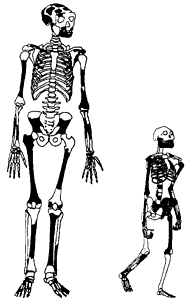
 |
|
|
Humans: One
big family
Trace back 10,000 generations and any family would
find their earliest ancestors on one of the Old World continents.
No matter where that generation resided, a trace of the same family back
2 million years would show its ancestors living in Africa.
| At that time, a population bottleneck allowed
early Homo sapiens to sprout off from Australopithecus progenitors.
In the years that followed, human ancestors colonized beyond the African
continent to the farthest reaches of the Old World. And according
to a new study published in the January issue of Molecular Biology and
Evolution, the Pliocene bottleneck was the last population isolation humans
faced.
John Hawks, Keith Hunley and Milford Wolpoff of the University of Michigan
and Sang-Hee Lee of the Graduate University for Advanced Studies in Kanagawa,
Japan, reviewed paleontological, archaeological, genetic, and statistical
data in order to determine how many bottlenecks humans have endured.
Recent evolutionary changes happened by natural selection in a widespread human population and not as a result of various isolations, says Hawks, now at the University of Utah. “This implies that human populations have been linked over a long period of time by interbreeding with each other, and have never been significantly isolated.” One of the key lines of evidence, and the inspiration for this research, was the wealth of human genetic data that has been collected in the past decades. Genetic evolutionary studies track speciations by estimating how long a particular gene has been accumulating in a given population. “We first got interested in this project when we noticed that the times estimated for nuclear genes are much older: averaging a million years or more,” Hawks says. The first task was to check the nuclear accumulation times to see if they differed significantly from the 2-million-year date, “when fossil and archaeological evidence tells us that major changes were happening,” says Hawks. While some subsets of mitochondrial data suggest that our ancestors were subjected to a population crash within the last 200,000 years, the nuclear genetic data do not appear to show this crash. |

Two million years ago, a small
The University of Michigan |
In addition to an increase in height (and an estimated doubling of weight), the early H. sapiens had developed a cranial buttressing system that strengthened the skull, a larger brain size, and larger neural canal. Early human ancestors also began to chew more towards the front of their mouths, grinding rather than crunching their food. Perhaps most importantly, the early H. sapiens also began hunting, gathering and scavenging, allowing them to significantly extend their range.
By 1.5 million years ago, our ancestors developed the handaxe and learned to butcher meat. And based on archaeological evidence, many researchers believe that soon after, early H. sapiens colonized the Old World tropics. Some researchers argue that these early Old World fossils belong to extinct species that are unrelated to humans, although “there is no pattern of differences that indicates such divisions,” Hawks says.
Depending on how a species is defined, anywhere from one to seven different species lived between these early African ancestors and today’s global society. And the differences between early H. sapiens and modern humans are slight.
“The only major differences are in the skull,” Hawks says, “and most of them are related to muscularity and brain size.” Many researchers have attributed these differences to population isolation. But other factors besides population size influence genetic variation, including natural selection, Hawks says.
In fact, the possibility of a natural selection mechanism for the evolution of modern humans is one of the main points of contention that has arisen since the publication of the new study. “We find that our conflicts with colleagues mainly center around this issue,” Hawks says. “It remains for them to find a hypothesis centered around small population size that has fossil and archaeological support. I don’t think such a hypothesis is going to be easy to find.”
Josh Chamot
Geotimes contributing writer